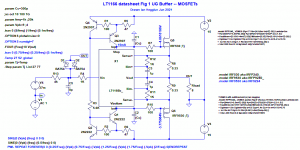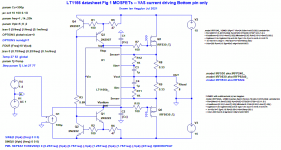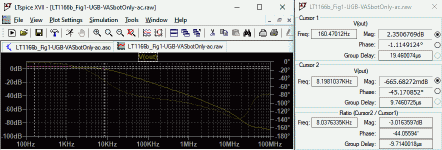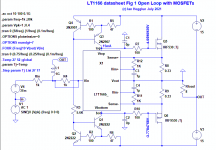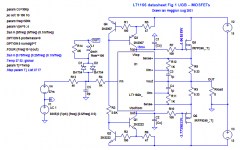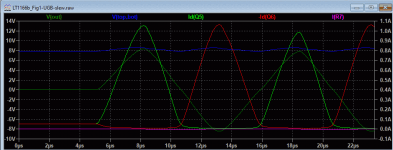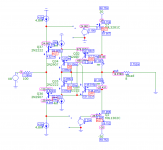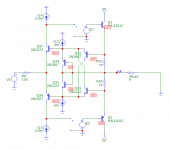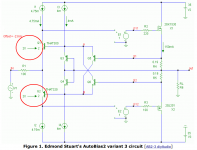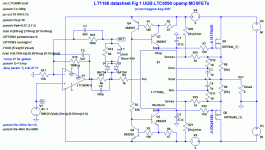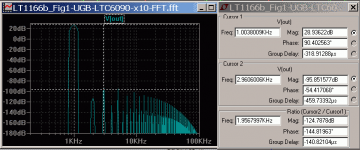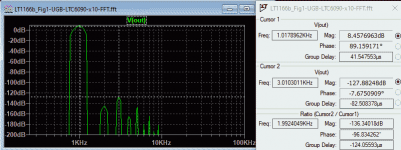Syn08 (Ovidiu) said this about implementing an Auto Bias loop here:
Well, there's the challenge. A wideband non switching Auto Bias amplifier circuit that works, doesn't oscillate and blow up, and is not too complex.
To start this thread I'll post some of my findings from simulations of the LT1166 Auto Bias IC, as well as Class-i and Edmond's AutoBias2.
Feel free to post any of your ideas and simulations.
And if anyone has built a successful amplifier using an auto bias circuit then we'd love to hear how you did it, etc.
Cheers, Ian
-------------
Edit: Some circuits:
Post 3 Syn08 LT1166 + HV opamp LM4702, LM4702 app Top/Bottom drive with Darlington's. Breadboarded 28KHz BW. Not datasheet version. Like Post 20.
Post 5 Type A: LT1166 Top/Bottom pin driven open loop voltage gain is 47dB, BW 15kHz. (Post 2 UGB version 8kHz BW with current source drive to Top/Bottom pins.)
Post 6 Voltage Gain Topology, LV opamp Top/Bottom pin driven, gain 20dB, ss-BW 3MHz. THD 0.002%. Post 27 shows slew limiting, OK up to 300kHz.
Post 11 Marcel van de Gevel links to his published and successful auto bias amplifier EW+WW Feb 1996. BW 140KHz, THD 0.006%. Has a cross-conduction crowbar (Q19,Q20) to trigger speaker relay. Ingenious non-complement design with a CA3046 array.
Post 14 Edmond Stuart's AutoBias2 circuit.
Post 20 Type B: HV opamp LT6090 Vin pin driven, ±50V 100W, SR 17V/us due to opamp OK to 50kHz. THD 0.0001% 100W and 0.000015% 1W.
Post 37 The LTspice library LT1166 model.
Post 45 Peufeu auto bias and non-switching basic circuit using Schottky diodes in place of source resistors as peufeu's thread here like the E Van Drecht patent. See Post 65.
Post 52 Syn08 Non-switching MOSFET 500W/4ohm, THD 0.0005%. No bias loop, CFP keep-on current, CFP uses current mirrors.
Post 53 Syn08 Simpler non-switching MOSFET, ±15V LME49710, No bias loop, CFP keep-on current, CFP with voltage gain uses current mirrors.
Post 65 CFA diamond splitter, output stage with voltage gain, Non-switching Rush Vbe multiplier coupled to Schottky diodes in the MOSFET sources (See Post 45).
Post 78 Comparison of a 4mR RDSon MOS-diode with a 10A Schottky diode show similar volt drop at 10A but temperature coefficient is negative for Schottky (results in thermal runaway in an autobias loop) and MOS-diode has a positive temp-co. (thermally safe in an autobias loop).
Post 90 Similar to Post 65 Vbe multiplier coupled to Schottky diodes in the MOSFET sources, but now Autobias by adding two current sources to add some DC voltage to the Schottky diodes allowing the trimpot to be eliminated. Once the current sources are carefully set you can change the power MOSFETs to BJTs and the idle current is almost the same -- thanks to the Autobias feedback loop. Q.E.D.
Post 93 Replace Schottky diodes with MOS-diodes. No Vbe multiplier feedback resistor used. No need to thermally couple the spreader to the power transistors. Autobias MOS-diodes keep the idle/crossover current much more stable than Schottky's.
Post 99 using IGBTs with autobias MOS-diodes. Changing to IGBTs gives about the same idle current without changing the bias settings -- thanks to the Autobias feedback loop. Sim'd THD doesn't change much no matter what power devices are used .
.
Post 105 All the autobias versions thus far are in one attached file including the latest versions of the electrothermal subcircuits. A tutorial for using these electrothermal 'widgets' with demo jigs is at my website.
Post 111 Pass F4 variant: Class-A buffer with autobias, 200W 4 ohms. Needs high level drive (40Vpk) preamp.
Post 115 Pass F4 variant: Class-A with autobias as a transconductance amplifier with gain, soft-clip, 200W 4 ohms, 0.001% 1W.
Post 116 Pass F4 variant: Class-A balanced bridge, autobias transconductance amplifier with gain, soft-clip, 100W 8 ohms, 0.001% 1W.
Post 135 bench tests with parallel IRF540N and MOS-diodes using the same. Good current sharing. Good linearity with 400mA bias. Over-compensation required thicker thermal washers for the MOS-diodes.
Post 137 bench tests with parallel IRF540N and two 10A Schottky diodes (instead of MOS-diodes). Current sharing resistors required. Good linearity with 400mA bias. Over-compensation required thicker thermal washers for the Schottky diodes.
Post 138 best thermal compensation so far with one of the autobias spreader transistors on one Schottky diode, the other spreader transistor at ambient to halve the temp.co ( now just right). Slice paralleling best as per LT1166 application note.
Post 141 Re design aims: minimalism and no source resistors. Ultra low THD is not necessary with no source resistors due to mainly low order harmonics up to 1W or so (thanks to the higher bias current for minimum distortion).
Post 150 bench test with MJL3281/1302 instead of MOSFETs. Good performance. Lower optimum bias with BJT's in place of MOSFETs.
Post 156 Bipolar power transistors without Darlington drivers as per E Van Drecht autobias patent and floating voltage offset for bias as peufeu Post 393.
Post 157 2 channel listening test with only 6dB voltage feedback, single 43V floating supply, sounds great and doesn't blow up. It works!
Post 158 Similar to Post 157 but with a diamond driver allowing higher input resistance of 10k but now requires compensation for stability (for when the input is open circuit). More voltage feedback gives lower output resistance. A zero feedback topology with very little local feedback - that's very rare.
Post 160 For those who want a non-floating standard power supply. LT6090-5 high voltage opamp - but it's not a fast opamp - sorry . BTW the floating supply versions above are not slew rate limited, only BW limited, so is the best option IMHO. Just parallel slices with higher voltage rails to get more power.
. BTW the floating supply versions above are not slew rate limited, only BW limited, so is the best option IMHO. Just parallel slices with higher voltage rails to get more power.
" I haven't see a solid non switching full solution for the entire audio band, but only partial improvements over the standard solution of an acceleration cap (100nF, in your case), which is not a solution for non switching, but only a bandaid to limit the effect of the crossover mess.
Part of this lack of solutions is of course keeping the complexity within reasonable limits; Edmond's solution mentioned above, in despite of it's stability issues, is already a rather complex circuit, and I don't think anything simpler could be designed and successfully implemented."
Well, there's the challenge. A wideband non switching Auto Bias amplifier circuit that works, doesn't oscillate and blow up, and is not too complex.
To start this thread I'll post some of my findings from simulations of the LT1166 Auto Bias IC, as well as Class-i and Edmond's AutoBias2.
Feel free to post any of your ideas and simulations.
And if anyone has built a successful amplifier using an auto bias circuit then we'd love to hear how you did it, etc.
Cheers, Ian
-------------
Edit: Some circuits:
Post 3 Syn08 LT1166 + HV opamp LM4702, LM4702 app Top/Bottom drive with Darlington's. Breadboarded 28KHz BW. Not datasheet version. Like Post 20.
Post 5 Type A: LT1166 Top/Bottom pin driven open loop voltage gain is 47dB, BW 15kHz. (Post 2 UGB version 8kHz BW with current source drive to Top/Bottom pins.)
Post 6 Voltage Gain Topology, LV opamp Top/Bottom pin driven, gain 20dB, ss-BW 3MHz. THD 0.002%. Post 27 shows slew limiting, OK up to 300kHz.
Post 11 Marcel van de Gevel links to his published and successful auto bias amplifier EW+WW Feb 1996. BW 140KHz, THD 0.006%. Has a cross-conduction crowbar (Q19,Q20) to trigger speaker relay. Ingenious non-complement design with a CA3046 array.
Post 14 Edmond Stuart's AutoBias2 circuit.
Post 20 Type B: HV opamp LT6090 Vin pin driven, ±50V 100W, SR 17V/us due to opamp OK to 50kHz. THD 0.0001% 100W and 0.000015% 1W.
Post 37 The LTspice library LT1166 model.
Post 45 Peufeu auto bias and non-switching basic circuit using Schottky diodes in place of source resistors as peufeu's thread here like the E Van Drecht patent. See Post 65.
Post 52 Syn08 Non-switching MOSFET 500W/4ohm, THD 0.0005%. No bias loop, CFP keep-on current, CFP uses current mirrors.
Post 53 Syn08 Simpler non-switching MOSFET, ±15V LME49710, No bias loop, CFP keep-on current, CFP with voltage gain uses current mirrors.
Post 65 CFA diamond splitter, output stage with voltage gain, Non-switching Rush Vbe multiplier coupled to Schottky diodes in the MOSFET sources (See Post 45).
Post 78 Comparison of a 4mR RDSon MOS-diode with a 10A Schottky diode show similar volt drop at 10A but temperature coefficient is negative for Schottky (results in thermal runaway in an autobias loop) and MOS-diode has a positive temp-co. (thermally safe in an autobias loop).
Post 90 Similar to Post 65 Vbe multiplier coupled to Schottky diodes in the MOSFET sources, but now Autobias by adding two current sources to add some DC voltage to the Schottky diodes allowing the trimpot to be eliminated. Once the current sources are carefully set you can change the power MOSFETs to BJTs and the idle current is almost the same -- thanks to the Autobias feedback loop. Q.E.D.
Post 93 Replace Schottky diodes with MOS-diodes. No Vbe multiplier feedback resistor used. No need to thermally couple the spreader to the power transistors. Autobias MOS-diodes keep the idle/crossover current much more stable than Schottky's.
Post 99 using IGBTs with autobias MOS-diodes. Changing to IGBTs gives about the same idle current without changing the bias settings -- thanks to the Autobias feedback loop. Sim'd THD doesn't change much no matter what power devices are used
Post 105 All the autobias versions thus far are in one attached file including the latest versions of the electrothermal subcircuits. A tutorial for using these electrothermal 'widgets' with demo jigs is at my website.
Post 111 Pass F4 variant: Class-A buffer with autobias, 200W 4 ohms. Needs high level drive (40Vpk) preamp.
Post 115 Pass F4 variant: Class-A with autobias as a transconductance amplifier with gain, soft-clip, 200W 4 ohms, 0.001% 1W.
Post 116 Pass F4 variant: Class-A balanced bridge, autobias transconductance amplifier with gain, soft-clip, 100W 8 ohms, 0.001% 1W.
Post 135 bench tests with parallel IRF540N and MOS-diodes using the same. Good current sharing. Good linearity with 400mA bias. Over-compensation required thicker thermal washers for the MOS-diodes.
Post 137 bench tests with parallel IRF540N and two 10A Schottky diodes (instead of MOS-diodes). Current sharing resistors required. Good linearity with 400mA bias. Over-compensation required thicker thermal washers for the Schottky diodes.
Post 138 best thermal compensation so far with one of the autobias spreader transistors on one Schottky diode, the other spreader transistor at ambient to halve the temp.co ( now just right). Slice paralleling best as per LT1166 application note.
Post 141 Re design aims: minimalism and no source resistors. Ultra low THD is not necessary with no source resistors due to mainly low order harmonics up to 1W or so (thanks to the higher bias current for minimum distortion).
Post 150 bench test with MJL3281/1302 instead of MOSFETs. Good performance. Lower optimum bias with BJT's in place of MOSFETs.
Post 156 Bipolar power transistors without Darlington drivers as per E Van Drecht autobias patent and floating voltage offset for bias as peufeu Post 393.
Post 157 2 channel listening test with only 6dB voltage feedback, single 43V floating supply, sounds great and doesn't blow up. It works!
Post 158 Similar to Post 157 but with a diamond driver allowing higher input resistance of 10k but now requires compensation for stability (for when the input is open circuit). More voltage feedback gives lower output resistance. A zero feedback topology with very little local feedback - that's very rare.
Post 160 For those who want a non-floating standard power supply. LT6090-5 high voltage opamp - but it's not a fast opamp - sorry
Last edited:
Some LT1166 sims
More from Syn08's post about implementing an Auto Bias loop using the LT1166 IC from here:
A simulations shows the LT1166 driven by a current source to the Bottom pin like a VAS would drive it.

The ac plot shows the f-3dB below as 8kHz

.
This is abysmal, pretty much unusable in this way as a drop-in Auto Bias generator. This may have been the way Syn08 used it? BTW The datasheet never showed it used in this way.
When the LT1166 is driven at the Vin pin (as below) like in the datasheet then the f-3dB is dramatically improved to about 1MHz. That's more like what we need.
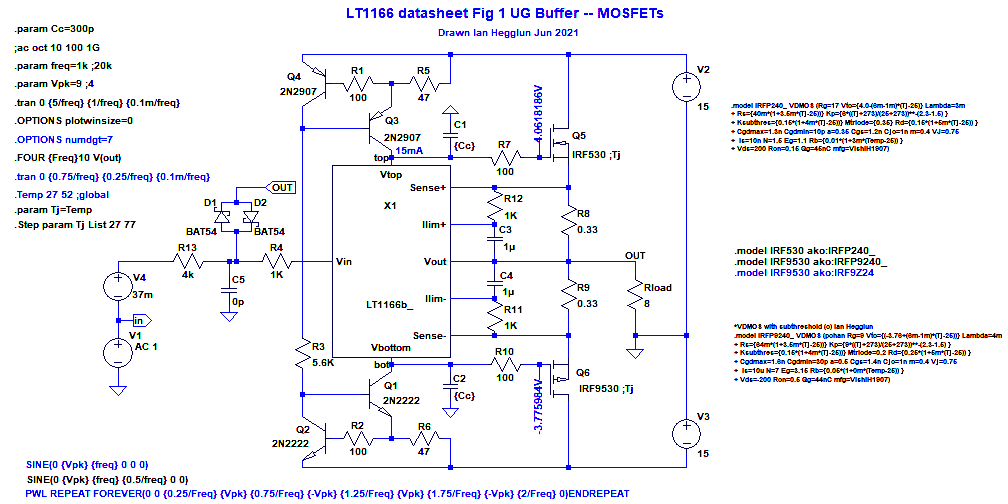

The simulation files are attached.
Included is a symmetrical VAS drive which is no different BW to the Bottom VAS drive.
Also a simulation with 1uF capacitors across the Top and Bottom pins to show they kill the Auto Bias IC altogether.
A paper on my simulation of the LT1166 is here: LT1166-Bias-Controller-Follower-Simulation.pdf - Google Drive
and the LTspice files are here: LT1166-Bias-Controller-Follower-Simulation-files.zip - Google Drive
More from Syn08's post about implementing an Auto Bias loop using the LT1166 IC from here:
...one reason why ICs like the LT1166 fail short for the full audio band applications; they simply don't have enough bandwidth to keep the above rule at audio HF (if memory serves from about 10 years ago, the LT1166 is effective only to about 4KHz...
A simulations shows the LT1166 driven by a current source to the Bottom pin like a VAS would drive it.
The ac plot shows the f-3dB below as 8kHz
.
This is abysmal, pretty much unusable in this way as a drop-in Auto Bias generator. This may have been the way Syn08 used it? BTW The datasheet never showed it used in this way.
When the LT1166 is driven at the Vin pin (as below) like in the datasheet then the f-3dB is dramatically improved to about 1MHz. That's more like what we need.
The simulation files are attached.
Included is a symmetrical VAS drive which is no different BW to the Bottom VAS drive.
Also a simulation with 1uF capacitors across the Top and Bottom pins to show they kill the Auto Bias IC altogether.
A paper on my simulation of the LT1166 is here: LT1166-Bias-Controller-Follower-Simulation.pdf - Google Drive
and the LTspice files are here: LT1166-Bias-Controller-Follower-Simulation-files.zip - Google Drive
Attachments
This is abysmal, pretty much unusable in this way as a drop-in Auto Bias generator. This may have been the way Syn08 used it? BTW The datasheet never showed it used in this way.
Yes, back in 2007
https://www.diyaudio.com/forums/solid-state/94204-contribution.html#post1107005
The data sheet shows this mode in Fig. 7 and 19. That's because the distortion performance when using the VIN pin is a dismal. I can confirm (by measurements) this disappointing performance over the VIN pin, so the conclusion is the LT1166 is a no win solution
LT1166 Vin pin
Hi Syn08,
Originally Posted by IanHegglun Post 2, "This is abysmal, pretty much unusable in this way as a drop-in Auto Bias generator. This may have been the way Syn08 used it? BTW The datasheet never showed it used in this way."
Reply by Syn08
Thanks for the link to your earlier posts. I was aware of driving the Top and Bottom pins (DS Fig 19) using an opamp, like your circuit.
But my circuit was driving the Bottom pin using a current source without any global feedback. When you use global feedback the opamps high gain takes over giving low distortion (like DC Fig 19) and wide bandwidth.
But then, how much is the LT1166 actually doing at HF if it starts to roll off at 15kHz?
The question about driving the Vin pin rather than the Top/Bottom pins -- which is it worse?
To try and answer this I used the circuit below to look at the open loop gain and phase plots. Things change with the input resistor Rin so I did several runs at 100 ohms, 1k, 5k and 100k. Notice the sources are grounded and the power rails are floating to make it open loop. The inductor is needed to maintain the same DC operating point as Rin changes.


.
With Rin 1k the open loop voltage gain is 47dB and f-3dB 15kHz. With 100 ohms it is 52dB (x400) and 15kHz. With 5k it is 37dB and 100k 12dB (all same freq). With 100 ohms the gm is 400/8=50 A/V and with 100k it is 0.5A/V. The open loop gm drops by half when Rin is about 1k.
This shows the behaviour of the Vin pin depends on what source resistance is used to drive it. If you use a current source to drive it you won't get much performance from the LT1166. If you connect it to a conventional VAS stage which is a very high resistance (at least at LF) then you need a buffer stage to get the best LF end performance with the LT1166 when driving the Vin pin.
What is the gain when driving the Top/Bottom pins?
Post 2 simulation shows you need to inject about 0.5mA into one of these nodes to get about 1A change at the output -- current gain (equiv. Hfe) of about 2000 times. BW 15kHz.
For this post the input current for 1A out is about 5mV (from1/gm= 1/200 with 1k Rin) into 1k is 5uA. That is 100th the current when driving the Top/Bottom pins in open loop. Same BW.
Why then can you get lower distortion by driving the Top/Bottom pins (as shown for DS Fig 19) and as others have proven? I think it is because driving Top/Bottom pins with an opamp and then the global feedback can bypass the LT1166 above open loop 15kHz rolloff.
Hi Syn08,
Originally Posted by IanHegglun Post 2, "This is abysmal, pretty much unusable in this way as a drop-in Auto Bias generator. This may have been the way Syn08 used it? BTW The datasheet never showed it used in this way."
Reply by Syn08
Yes, back in 2007
My small contribution
The data sheet shows this mode in Fig. 7 and 19. That's because the distortion performance when using the VIN pin is a dismal. I can confirm (by measurements) this disappointing performance over the VIN pin, so the conclusion is the LT1166 is a no win solution
Thanks for the link to your earlier posts. I was aware of driving the Top and Bottom pins (DS Fig 19) using an opamp, like your circuit.
But my circuit was driving the Bottom pin using a current source without any global feedback. When you use global feedback the opamps high gain takes over giving low distortion (like DC Fig 19) and wide bandwidth.
But then, how much is the LT1166 actually doing at HF if it starts to roll off at 15kHz?
The question about driving the Vin pin rather than the Top/Bottom pins -- which is it worse?
To try and answer this I used the circuit below to look at the open loop gain and phase plots. Things change with the input resistor Rin so I did several runs at 100 ohms, 1k, 5k and 100k. Notice the sources are grounded and the power rails are floating to make it open loop. The inductor is needed to maintain the same DC operating point as Rin changes.
.
With Rin 1k the open loop voltage gain is 47dB and f-3dB 15kHz. With 100 ohms it is 52dB (x400) and 15kHz. With 5k it is 37dB and 100k 12dB (all same freq). With 100 ohms the gm is 400/8=50 A/V and with 100k it is 0.5A/V. The open loop gm drops by half when Rin is about 1k.
This shows the behaviour of the Vin pin depends on what source resistance is used to drive it. If you use a current source to drive it you won't get much performance from the LT1166. If you connect it to a conventional VAS stage which is a very high resistance (at least at LF) then you need a buffer stage to get the best LF end performance with the LT1166 when driving the Vin pin.
What is the gain when driving the Top/Bottom pins?
Post 2 simulation shows you need to inject about 0.5mA into one of these nodes to get about 1A change at the output -- current gain (equiv. Hfe) of about 2000 times. BW 15kHz.
For this post the input current for 1A out is about 5mV (from1/gm= 1/200 with 1k Rin) into 1k is 5uA. That is 100th the current when driving the Top/Bottom pins in open loop. Same BW.
Why then can you get lower distortion by driving the Top/Bottom pins (as shown for DS Fig 19) and as others have proven? I think it is because driving Top/Bottom pins with an opamp and then the global feedback can bypass the LT1166 above open loop 15kHz rolloff.
Attachments
Last edited:
LT1166 opamp Top/Bottom pin drive *and* Vin pin drive
Here's a simulation of the LT1166 with an opamp driving the Top/Bottom pins and the Vin pin. Notice it uses floating PS rails so a standard voltage audio opamp can be used.
.
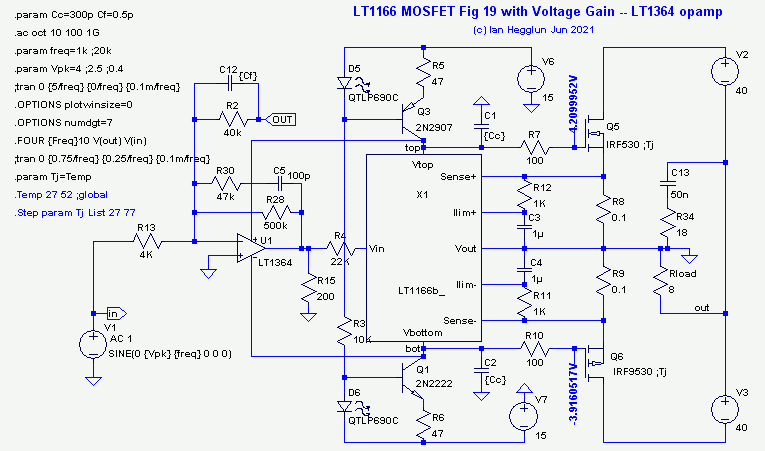

.
With a voltage gain of 20dB the BW is 3MHz. THD is quite low 0.002% at 1kHz.
.

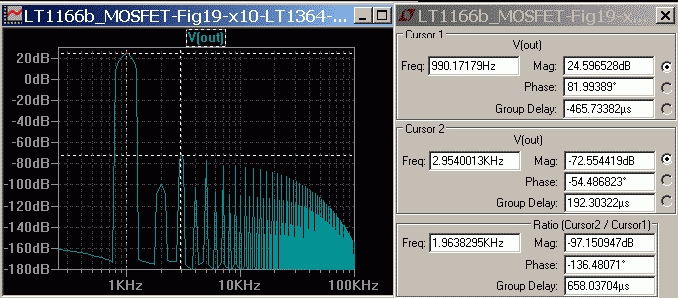
.
Driving the Vin pin as well as the Top/Bottom pins adds some extra loop gain below 15kHz. R4 needs to be above 10k to prevent the LT1166 getting too confused . To see the effect of R4 in an ac plot replace R2 with a 1GH inductor.
. To see the effect of R4 in an ac plot replace R2 with a 1GH inductor.
Sim files are attached (including the ones for the previous post for open loop).
Here's a simulation of the LT1166 with an opamp driving the Top/Bottom pins and the Vin pin. Notice it uses floating PS rails so a standard voltage audio opamp can be used.
.
.
With a voltage gain of 20dB the BW is 3MHz. THD is quite low 0.002% at 1kHz.
.
.
Driving the Vin pin as well as the Top/Bottom pins adds some extra loop gain below 15kHz. R4 needs to be above 10k to prevent the LT1166 getting too confused
Sim files are attached (including the ones for the previous post for open loop).
Attachments
-
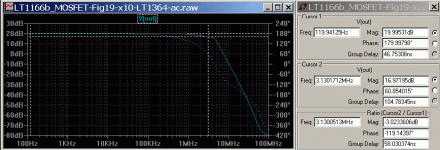 LT1166b_MOSFET-Fig19-x10-LT1364-ac.png11.4 KB · Views: 2,991
LT1166b_MOSFET-Fig19-x10-LT1364-ac.png11.4 KB · Views: 2,991 -
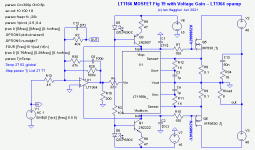 LT1166b_MOSFET-Fig19-x10-LT1364-cct.png13.2 KB · Views: 3,148
LT1166b_MOSFET-Fig19-x10-LT1364-cct.png13.2 KB · Views: 3,148 -
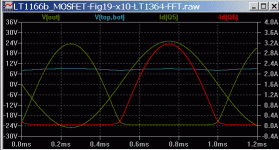 LT1166b_MOSFET-Fig19-x10-LT1364-25V-1kHz.png7.9 KB · Views: 3,003
LT1166b_MOSFET-Fig19-x10-LT1364-25V-1kHz.png7.9 KB · Views: 3,003 -
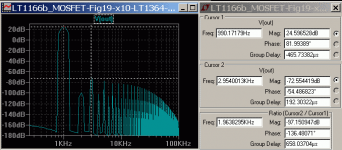 LT1166b_MOSFET-Fig19-x10-LT1364-FFT.png10.1 KB · Views: 3,008
LT1166b_MOSFET-Fig19-x10-LT1364-FFT.png10.1 KB · Views: 3,008 -
LT1166b_MOSFET-Fig19-x10-LT1364.zip12.4 KB · Views: 105
-
LT1166b_Fig1-OL-ac.zip6.7 KB · Views: 106
Test report:
The emitter-resistor-free BJT output stage is running fine with the new temperature compensation bias circuit.
It does have a wider crossover than with the resistors, and the transistors switch later and softer, but... they do switch and they still make crossover spikes. So the quest for non-switching is still on.
Power amp OUTPUT STAGE measurements shootout
The emitter-resistor-free BJT output stage is running fine with the new temperature compensation bias circuit.
It does have a wider crossover than with the resistors, and the transistors switch later and softer, but... they do switch and they still make crossover spikes. So the quest for non-switching is still on.
Power amp OUTPUT STAGE measurements shootout
syn08 I think I've found out why you got AutoBias2 to latch up. I got it to latch up in the simulator.
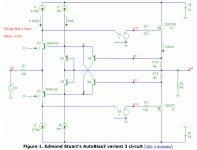
If, due to some unfortunate circumstances, both Q5 and Q6 turn off at the same time... then Q1 and Q2 are only controlled by the diode transistors Q3 Q4 which means they sink a collector current of about 4mA. Since I1 and I3 source more than 4mA, Q1 and Q2 can't keep the bias voltage under control, and it rises. Since that increases the voltage across the emitter resistors, that keeps Q5 and Q6 off, which means it is latched up at the maximum bias current the power supply will provide.

If, due to some unfortunate circumstances, both Q5 and Q6 turn off at the same time... then Q1 and Q2 are only controlled by the diode transistors Q3 Q4 which means they sink a collector current of about 4mA. Since I1 and I3 source more than 4mA, Q1 and Q2 can't keep the bias voltage under control, and it rises. Since that increases the voltage across the emitter resistors, that keeps Q5 and Q6 off, which means it is latched up at the maximum bias current the power supply will provide.
Slew rate workout
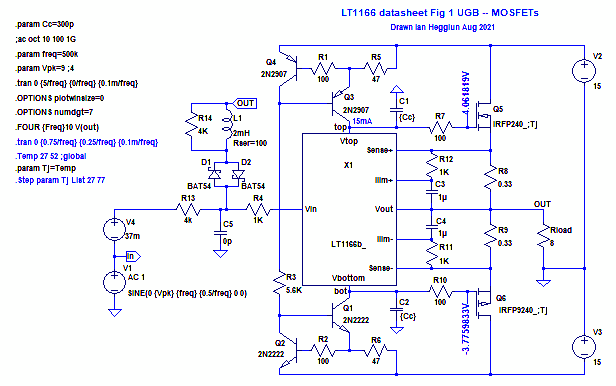
.
Without the inductor in series with the diodes the slew rate is 4V/us which limits full swing to 100kHz (below) with a sinewave (slew limiting makes it triangular)

.
With the inductor the slew rate peaks at 20V/us allowing full swing of 8Vpk at 300kHz (below)

.
Now with the inductor at 500kHz the LT1166 cannot maintain its proper control and the bias voltage falls causing severe crossover distortion

.
Notice the LT1166 when operated beyond its control limit does not give cross-conduction which is a very desirable thing for any bias system. Cross-conduction at high frequency causes excessive dissipation and usually eventual destruction as the heatsink heats up. So auto bias circuits need to be checked for cross-conduction when pushed to their limits. And driven by 1MHz the MOSFETs stop conducting after a few cycles. Looking good .
.
This partly answers my question, that the LT1166 Vin pin drive does allow safe control of the MOSFETs even when pushed into slew rate limiting.
With higher voltage rails, like used in most power amps, the slew rate is high enough for operation to 100kHz (eg +/-50V rails), and that is without an emitter follower to drive the MOSFETs.
Looks like the LT1166 is not as bad as some have found. Looks OK for full the 20kHz.
BTW paralleling MOSFET's with a single LT1166 is not a recommended option, several IC's as "slices" should be used, like paralleling opamps, with 0.1 ohms sharing resistors to the output node.
The next question: Does that safe operation with SR limiting also apply to driving the top and bottom pins with an opamp? Yet to confirm.
I'm still thinking about this question. Some more simulations using the Vin pin. This time slew rate simulations with a 9V input - just below clip with a 15V rails using the Datasheet Fig 1 circuit again as below - but with mods to the Schottky clamp diodes for higher slew rates....my circuit was driving the Bottom pin using a current source without any global feedback. When you use global feedback the opamps high gain takes over giving low distortion (like DC Fig 19) and wide bandwidth.
But then, how much is the LT1166 actually doing at HF if it starts to roll off at 15kHz?
.
Without the inductor in series with the diodes the slew rate is 4V/us which limits full swing to 100kHz (below) with a sinewave (slew limiting makes it triangular)
.
With the inductor the slew rate peaks at 20V/us allowing full swing of 8Vpk at 300kHz (below)
.
Now with the inductor at 500kHz the LT1166 cannot maintain its proper control and the bias voltage falls causing severe crossover distortion
.
Notice the LT1166 when operated beyond its control limit does not give cross-conduction which is a very desirable thing for any bias system. Cross-conduction at high frequency causes excessive dissipation and usually eventual destruction as the heatsink heats up. So auto bias circuits need to be checked for cross-conduction when pushed to their limits. And driven by 1MHz the MOSFETs stop conducting after a few cycles. Looking good
This partly answers my question, that the LT1166 Vin pin drive does allow safe control of the MOSFETs even when pushed into slew rate limiting.
With higher voltage rails, like used in most power amps, the slew rate is high enough for operation to 100kHz (eg +/-50V rails), and that is without an emitter follower to drive the MOSFETs.
Looks like the LT1166 is not as bad as some have found. Looks OK for full the 20kHz.
BTW paralleling MOSFET's with a single LT1166 is not a recommended option, several IC's as "slices" should be used, like paralleling opamps, with 0.1 ohms sharing resistors to the output node.
The next question: Does that safe operation with SR limiting also apply to driving the top and bottom pins with an opamp? Yet to confirm.
Attachments
A wideband non switching Auto Bias amplifier circuit that works, doesn't oscillate and blow up, and is not too complex.
To start this thread I'll post some of my findings from simulations of the LT1166 Auto Bias IC, as well as Class-i and Edmond's AutoBias2.
Feel free to post any of your ideas and simulations.
And if anyone has built a successful amplifier using an auto bias circuit then we'd love to hear how you did it, etc.
I don't know if it meets your requirements, but my amplifier from the mid-1990's still hasn't exploded.
https://worldradiohistory.com/hd2/I...tronics-World-1996-02-S-OCR-OCR-Page-0054.pdf
https://worldradiohistory.com/hd2/I...tronics-World-1996-02-S-OCR-OCR-Page-0055.pdf
https://worldradiohistory.com/hd2/I...tronics-World-1996-02-S-OCR-OCR-Page-0056.pdf
https://worldradiohistory.com/hd2/I...tronics-World-1996-02-S-OCR-OCR-Page-0057.pdf
latch up?
Cheers, E.
Just the opposite. In that case the bias current is almost zero and if one of them (Q5 or Q6) is turned off, the bias current is about halved,syn08 I think I've found out why you got AutoBias2 to latch up. I got it to latch up in the simulator.
View attachment 971342
If, due to some unfortunate circumstances, both Q5 and Q6 turn off at the same time... then Q1 and Q2 are only controlled by the diode transistors Q3 Q4 which means they sink a collector current of about 4mA. Since I1 and I3 source more than 4mA, Q1 and Q2 can't keep the bias voltage under control, and it rises. Since that increases the voltage across the emitter resistors, that keeps Q5 and Q6 off, which means it is latched up at the maximum bias current the power supply will provide.
Cheers, E.
You have overlooked that Q1 and Q2 have a value of 2 (i.e. 2 pieces in parallel), see attachment.According to the simulator, it seems like a stable latched-up state. Where is the mistake?
Cheers, E.
Attachments
Nice, that solves the issue.
Is there a reference implementation somewhere? I would like to build one to compare to resistor-free BJTs, but I would rather not spend too much time on stability issues.
Do you see any improvement in simulation?
Hi peufeu,Why use a non-switching controller with MOSFETs when MOSFETs don't make turn-off spikes like BJTs do?
MOSFETs still have wide variations in the wingspread curves with junction temperature changes due to music power variations. Also startup of amp.
Further, a bias controller removes the necessity for the bias trimpot. With a pot there is a range of different listening outcomes for the same amp depending on were you set your pot compared to where someone sels their pot.
And one more. Variations in the MOSFET's p/n (mis)match don't matter much. The controller loop feedback removes most of these at the lower frequencies (like the 1-3kHz region). In fact, even with power BJT's controllers give almost the same wingspread plot (singular), which becomes a generic curve (it hardly changes once you pick the source resistor value). So BJT's and MOSFET's merge in their 'sound' -- and then with enough feedback the crossover distortion becomes inaudible over the whole audio range.
Well, that's ideally. But in reality lots of problems lurk with controller loops, like clip recovery and possibly unresolved stability (compensation) issues, eg, with certain types of loads and speaker cables. These problems lurk with standard amps as well but bias controllers add another layer of difficulty for these problems.
A post to follow this: showing the effect of 0.33 ohm and 0.05 ohm source resistors on the wingspread curve for the LT1166.
Effect of source resistor value on LT1166 THD
I use the circuit below
.

.
With source resistors of 0.33 ohms (as per DS Fig 1) the idle current is 55mA.
With source resistors of 0.05 ohms the idle current is 300mA.
The minimum current is trimmed by adding some offset voltage to the Sense inputs. With 50k and 10 ohms from the 15V rail the minimum current is reduced from 150mA to 50mA (thats for Rs=50mR).
The current plot for 0.33 ohms below for Tj of 27C and 77C (MOSFETs only)
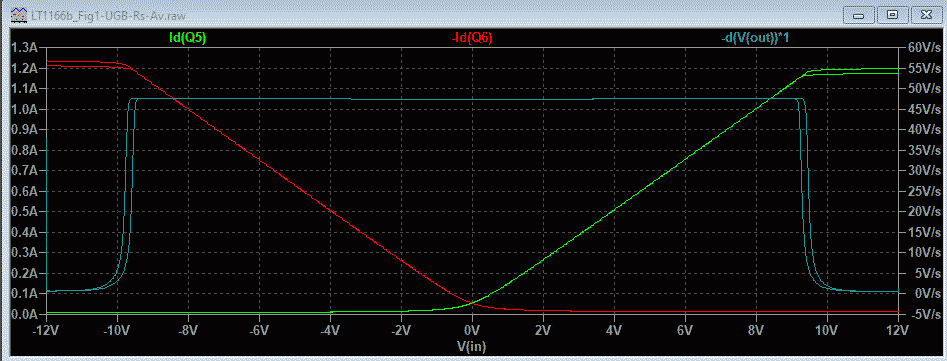
The wingspread plot for 0.33 ohms below for Tj of 27C and 77C (MOSFETs only)
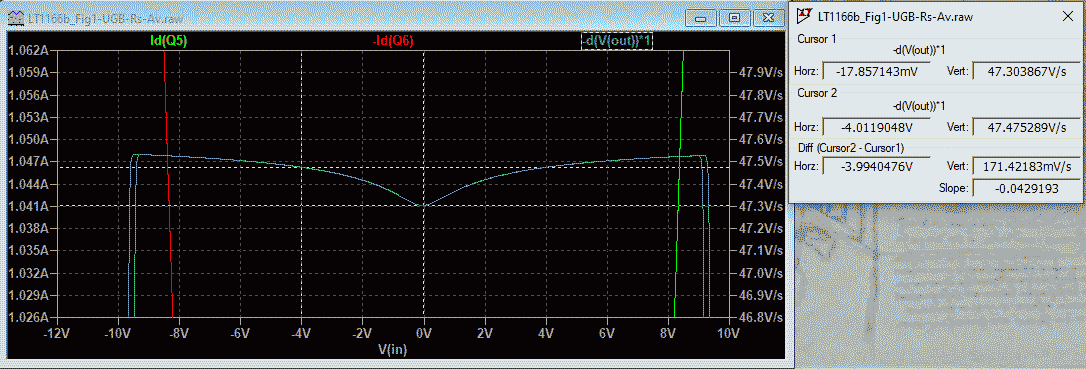
The current plot for 0.05 ohms below

The wingspread plot for 0.05 ohms below

.
Distortion figures for 0.33 ohms at 1kHz/8R are:
TJ=27 degC ..... 0.0403% and 0.0366% at 9Vpk and 4Vpk respectively
TJ=77 degC ..... 0.0408% and 0.0379% at 9Vpk and 4Vpk
Distortion figures for 0.05 ohms at 1kHz/8R are:
TJ=27 degC ..... 0.0101% and 0.0011% at 9Vpk and 4Vpk respectively
TJ=77 degC ..... 0.0095% and 0.00099% at 9Vpk and 4Vpk.
Notice how small the difference in THD is when Tj of the MOSFETs change by 50 degrees C. It is miniscule, so no thermal lag distortion and no warmup time required. That makes bias loops look so useful.
Notice with 0.05 ohm source resistors the THD for 4V peak (about 1W/8R) is only 0.001% at 1kHz. With 0.33 ohm source resistors its 30 times higher. The idle current is about 5 times higher. Looks like a worthwhile trade to me.
I use the circuit below
.
.
With source resistors of 0.33 ohms (as per DS Fig 1) the idle current is 55mA.
With source resistors of 0.05 ohms the idle current is 300mA.
The minimum current is trimmed by adding some offset voltage to the Sense inputs. With 50k and 10 ohms from the 15V rail the minimum current is reduced from 150mA to 50mA (thats for Rs=50mR).
The current plot for 0.33 ohms below for Tj of 27C and 77C (MOSFETs only)
The wingspread plot for 0.33 ohms below for Tj of 27C and 77C (MOSFETs only)
The current plot for 0.05 ohms below
The wingspread plot for 0.05 ohms below
.
Distortion figures for 0.33 ohms at 1kHz/8R are:
TJ=27 degC ..... 0.0403% and 0.0366% at 9Vpk and 4Vpk respectively
TJ=77 degC ..... 0.0408% and 0.0379% at 9Vpk and 4Vpk
Distortion figures for 0.05 ohms at 1kHz/8R are:
TJ=27 degC ..... 0.0101% and 0.0011% at 9Vpk and 4Vpk respectively
TJ=77 degC ..... 0.0095% and 0.00099% at 9Vpk and 4Vpk.
Notice how small the difference in THD is when Tj of the MOSFETs change by 50 degrees C. It is miniscule, so no thermal lag distortion and no warmup time required. That makes bias loops look so useful.
Notice with 0.05 ohm source resistors the THD for 4V peak (about 1W/8R) is only 0.001% at 1kHz. With 0.33 ohm source resistors its 30 times higher. The idle current is about 5 times higher. Looks like a worthwhile trade to me.
Attachments
-
LT1166b_Fig1-UGB-Rs.zip9.7 KB · Views: 76
-
 LT1166b_Fig1-UGB-Rs-50m-gm.png21.8 KB · Views: 1,903
LT1166b_Fig1-UGB-Rs-50m-gm.png21.8 KB · Views: 1,903 -
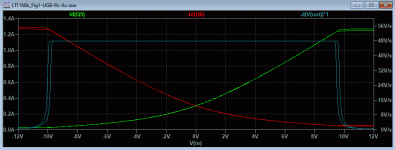 LT1166b_Fig1-UGB-Rs-50m.png8.9 KB · Views: 1,940
LT1166b_Fig1-UGB-Rs-50m.png8.9 KB · Views: 1,940 -
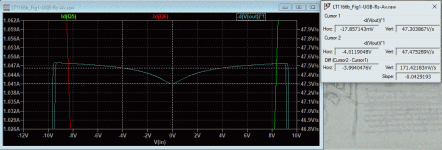 LT1166b_Fig1-UGB-Rs-330m-gm.png23.8 KB · Views: 1,955
LT1166b_Fig1-UGB-Rs-330m-gm.png23.8 KB · Views: 1,955 -
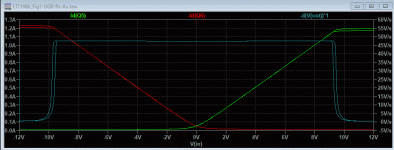 LT1166b_Fig1-UGB-Rs-330m.png10.4 KB · Views: 1,962
LT1166b_Fig1-UGB-Rs-330m.png10.4 KB · Views: 1,962 -
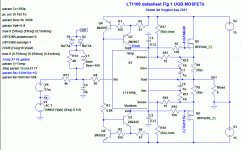 LT1166b_Fig1-UGB-Rs-cct.png18.3 KB · Views: 2,045
LT1166b_Fig1-UGB-Rs-cct.png18.3 KB · Views: 2,045
Hi Marcel,I don't know if it meets your requirements, but my amplifier from the mid-1990's still hasn't exploded.
Yes, it is a fantastic example of a bias loop that doesn't blow up. Thanks.
It shows your design abilities are way beyond most of ours here, including mine.
BTW did you try the LT1166, or any other discrete types? We'd love to hear any problems or success(s).
I find it interesting that about 5 of the 80 or so amplifier articles in Electronics World + WW that I surveyed (from the late 1970's to late 1990's) were not the standard topology (some call the Blameless topology, Bob Cordell calls the Thompson topology, and I call the Lin topology).
Yours is one of the five. Other 4: Ivor Brown's (Dec 1994), the Macura Follower, my Square-law Sep 1995, and Class-T. (Apologies if I missed some ones).
I'd give yours the top prize of all power amp designs in EW/WW - no kidding.
Possible amp using the LT1166
This is a follow up on the slew rate post. I have added a LTC6090 high voltage opamp as a driver for the LT1166 Vin pin (below). BTW the datasheet does not show a circuit using a high voltage opamp (closest is Fig 19 with "suspended supply operation" with lower voltage opamps that need 0.1% resistors).
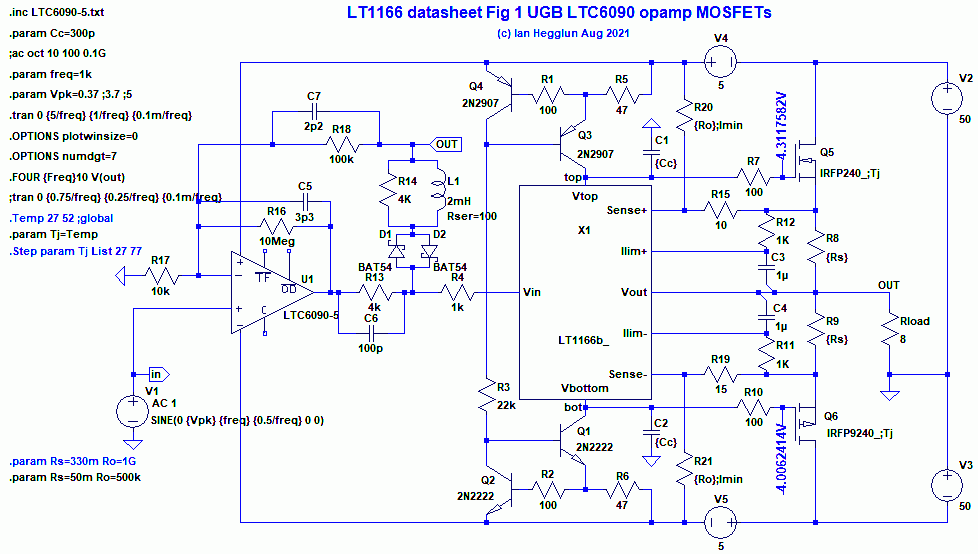
The rails are +/-50V with 5V lift for the CCS and opamp headroom, giving 40Vpk output into 4 ohms. It is 100W intended for 8 ohms.
With the LTC6090-5 the slew rate is 17V/us. This amplifier achieves 10V/us which gives full 40V at 50kHz without slew rate limiting. No cross-conduction issues at any frequency. Clip recovery OK. (BTW if the opamp was twice as fast the LT1166 should do 100kHz before slew rate limiting).
Distortion with 0.33 ohm source resistors at 1kHz: 0.00042% 40Vpk and 0.00049% 4Vpk
Distortion with 0.05 ohm source resistors at 1kHz: 0.00010% 40Vpk (FFT below) and 0.000015% 4Vpk (FFT below)
Distortion is about 10 times higher at 10kHz, and 100 times higher at 50kHz.
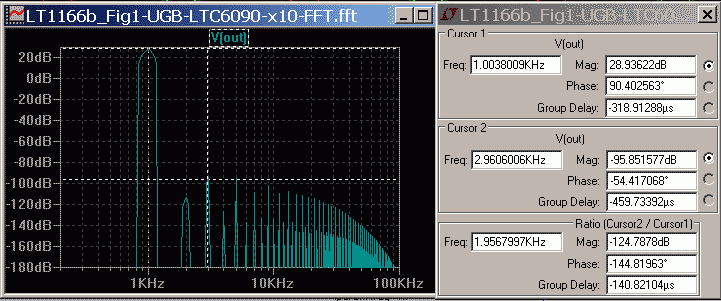
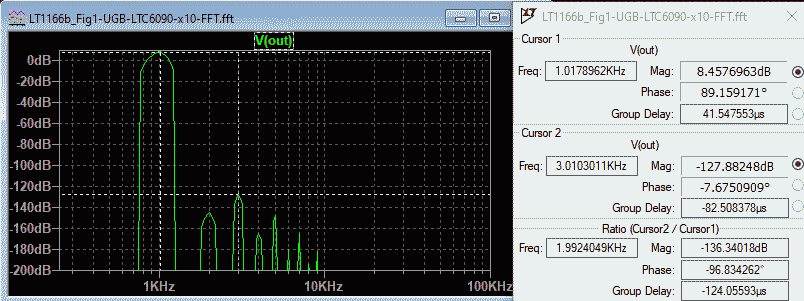
This is a follow up on the slew rate post. I have added a LTC6090 high voltage opamp as a driver for the LT1166 Vin pin (below). BTW the datasheet does not show a circuit using a high voltage opamp (closest is Fig 19 with "suspended supply operation" with lower voltage opamps that need 0.1% resistors).
The rails are +/-50V with 5V lift for the CCS and opamp headroom, giving 40Vpk output into 4 ohms. It is 100W intended for 8 ohms.
With the LTC6090-5 the slew rate is 17V/us. This amplifier achieves 10V/us which gives full 40V at 50kHz without slew rate limiting. No cross-conduction issues at any frequency. Clip recovery OK. (BTW if the opamp was twice as fast the LT1166 should do 100kHz before slew rate limiting).
Distortion with 0.33 ohm source resistors at 1kHz: 0.00042% 40Vpk and 0.00049% 4Vpk
Distortion with 0.05 ohm source resistors at 1kHz: 0.00010% 40Vpk (FFT below) and 0.000015% 4Vpk (FFT below)
Distortion is about 10 times higher at 10kHz, and 100 times higher at 50kHz.
Attachments
- Home
- Amplifiers
- Solid State
- Towards a wideband non switching Auto Bias power amp
